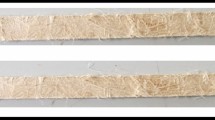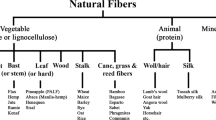Abstract
Sugar palm fiber is one of the most abundant natural fibers used in biocomposites. However, prediction of the mechanical properties of such natural fiber reinforced composites is still challenging. Most of the theoretical modelings are based the micromechanical method. There have been little studies involving statistical approach for prediction of mechanical properties of natural fiber reinforced composites. In this study, the tensile properties of short sugar palm fiber-reinforced high impact polystyrene (SPF-HIPS) composites obtained by means of statistical approach were investigated and compared with the experimental observations and with micromechanical models available in the literature. Statistical approach was used to predict the performance of the composite part with different fiber loadings. A two-parameter Weibull distribution function was used to model the fiber length distribution in the composite. For the experimental validation, the composites were prepared by hot compression technique for different fiber loadings (10 %, 20 %, 30 %, 40 % and 50 % by weight). Tensile testing of the composites was carried out according to ASTM D638 to obtain the composites tensile strength and modulus of elasticity. Experimental results showed that the tensile strength of the composite reduced due to the addition of sugar palm fibers, whereas the elastic modulus increased by a factor of up to 1.34. The current statistical model predicted the tensile properties of SPF-HIPS composite close to the experimental values. It was found that statistical approach with standard micromechanical models can be used to predict the mechanical properties of sugar palm fiber reinforced HIPS composites. Hence, this study could assist in decisions regarding the design of natural fiber reinforced composite products.
Similar content being viewed by others
References
A. S. Singha and V. K. Thankur, Bull. Mater. Sci., 31, 791 (2008).
D. Bachtiar, S. M. Sapuan, and M. M. Hamdan, International Journal of Automotive and Mechanical Engineering (IJAME), 1, 79 (2010).
J. P. Siregar, Master of Science Thesis, UPM, Kuala Lumpur, 2005.
D. Bachtiar, S. M. Sapuan, and M. M. Hamdan, Mater. Des., 29, 1285 (2008).
S. M. Sapuan and D. Bachtiar, Procedia Chemistry, 4, 101 (2012).
D. Bachtiar, S. M. Sapuan, E. S. Zainuddin, A. Khalina, and K. Z. H. M. Dahlan, Fiber. Polym., 13, 894 (2012).
Z. Leman, S. M. Sapuan, A. M. Saifol, M. A. Maleque, and M. M. H. M. Ahmad, Mater. Des., 29, 1666 (2008).
Z. Leman, S. M. Sapuan, M. Azwan, M. M. H. M. Ahmad, and M. A. Maleque, Polym. Plast. Technol. Eng., 47, 606 (2008).
L. J. Da Silva, T. H. Panzera, A. L. Christoforo, J. C. C. Rubio, and F. Scarpa, Mater. Res., 15, 1003 (2012).
A. Alhuthali, I. M. Low, and C. Dong, Compos. Part BEng., 43, 2772 (2012).
A. G. Facca, M. T. Kortschot, and N. Yan, Compos. Part AAppl. S., 37, 1660 (2006).
D. Bachtiar, S. M. Sapuan, E. S. Zainudin, A. Khalina, and K. Z. H. M. Dahlan, Pertanika J. Sci. Technol., 21, 141 (2013).
J. Sahari, S. M. Sapuan, Z. N. Ismarrubie, and M. Z. A. Rahman, Fibres Text East Eur., 20, 21 (2012).
S. Y. Fu and B. Lauke, Compos. Sci. Technol., 56, 1179 (1996).
H. Derek and T. W. Clyne, “An Introduction to Composite Materials”, Cambridge University, Cambridge, 1981.
F. Vilaseca, A. V. Gonzalez, P. J. H. Franco, J. P. L. M. A. Pèlach, and P. Mutjé, Bioresource Technology, 101, 387 (2010).
S. Shibata, Y. Cao, and I. Fukumoto, Compos. Part AAppl. S., 39, 640 (2008).
D. C. Montgomery and G. C. Runger, “Applied Statistics and Probability for Engineers”, 2nd ed., John Wiley and Sons, 1999.
P. Antich, A. Vazquez, I. Mondragon, and C. Bernal, Compos. Part A-Appl. S., 37, 139 (2006).
Author information
Authors and Affiliations
Corresponding authors
Rights and permissions
About this article
Cite this article
Oumer, A.N., Bachtiar, D. Modeling and experimental validation of tensile properties of sugar palm fiber reinforced high impact polystyrene composites. Fibers Polym 15, 334–339 (2014). https://doi.org/10.1007/s12221-014-0334-5
Received:
Revised:
Accepted:
Published:
Issue Date:
DOI: https://doi.org/10.1007/s12221-014-0334-5




